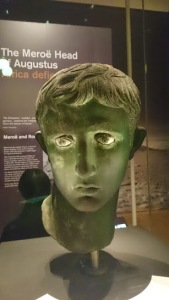Last night I took a trip to my most favourite building in the world, the British Museum, with my partner. I was going for one special reason, to see the Meroe Head in its own special room; I had of course seen the head before but this time it was being viewed in a new light, allowing visitors to understand the head in its bigger context and history. Before going to see the head of Augustus, we took a stroll over to Room 90 to visit Bonaparte.
Now, it is well known that Napoleon Bonaparte took a shine, like many before and after him, to the prominence of the Roman empire, and in particular the figure of Augustus as an image to base himself on. When I walked into exibition, however, I was amazed to see a head figured very much like the Meroe Head itself.
Just look at that face, the gaze, that pose, the hair alone… It has Augustus, shown on the right (the Meroe Head), written all over it. To top this all off, written in Greek around the bottom of the bust, at the bottom of the pillar, is a passage from the Odyssey. Both heads would have been used to disseminate the idealised images of each empire’s rulers.
The similarities don’t stop there; both Augustus and Napoleon were creators and leaders of empires, created out of civil unrest and great violence, both abandoning republican politics for authoritarian rule. However, indisputably Augustus’ rule extended far beyond that of Napoleon, and his control of his image and how it was disseminated throughout the world was far more sophisticated. Just take a look at this cartoon from my trip last night…
In this Bonaparte says ‘Away from my sight peace, thou art hateful to me’, while the devil rowing says ‘We shall wade through seas of blood after this…’ Meanwhile the evil looking skeleton declares ‘A more expert trade at my hand does not exist’. The little fellow on the bank shouts ‘Oh Heartwell I sigh for thy peaceful shades’. Apologies, as I am not an expert in the affairs of Napoleon, I can’t explain the land chap’s speech, but I think it is pretty clear to all what the figures in the boat are referring to. I think it is also reasonable to state that there would have been a good number of Roman citizens in the empire feeling similar to the man on the land, viewing Augustus as a ‘reckless’ Napoleon of their day. This scene would have been especially relatable to those seeing the civil war following the events of the Ides of March.
As a last note, take a good look at this. On the left you can see where the Meroe Head was found, beneath the steps of a temple, for the Meroe people to step on his decapitated head when going about their daily business, thus secretely reminding themselves of their defiance of Roman rule years before when they removed all images of Augustus. On the right is the resting place of the Meroe head itself, this picture taken at the time it was found. Whatever the similarities between the two busts I came across at the museum yesterday, I feel sure that Napoleon’s head wasn’t found in the same compromising position!




